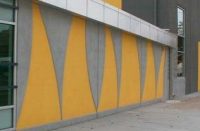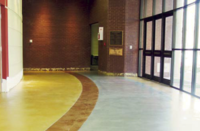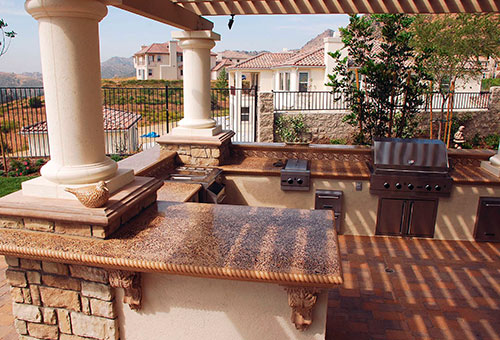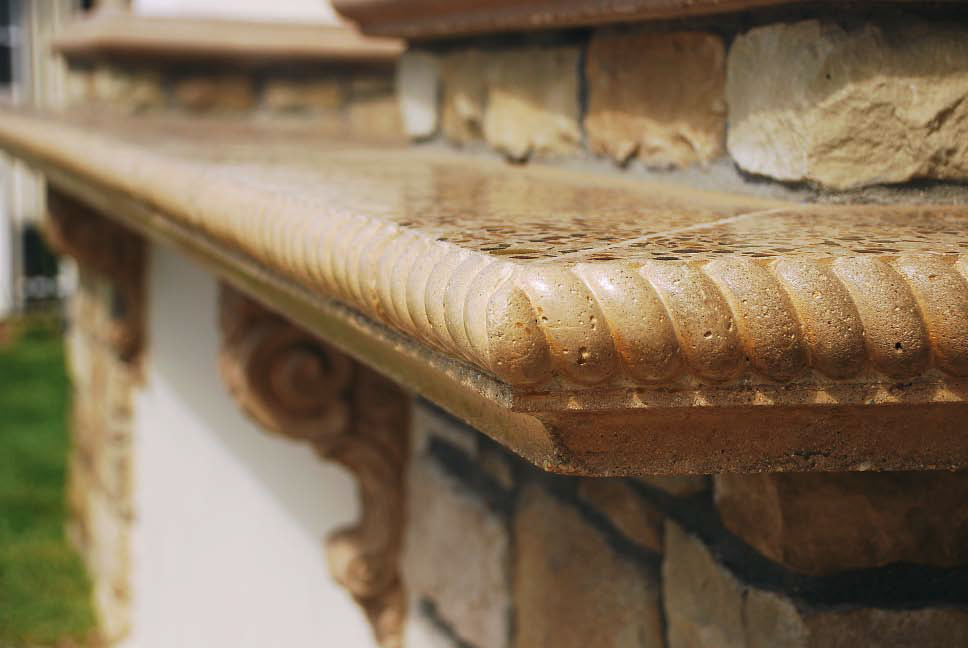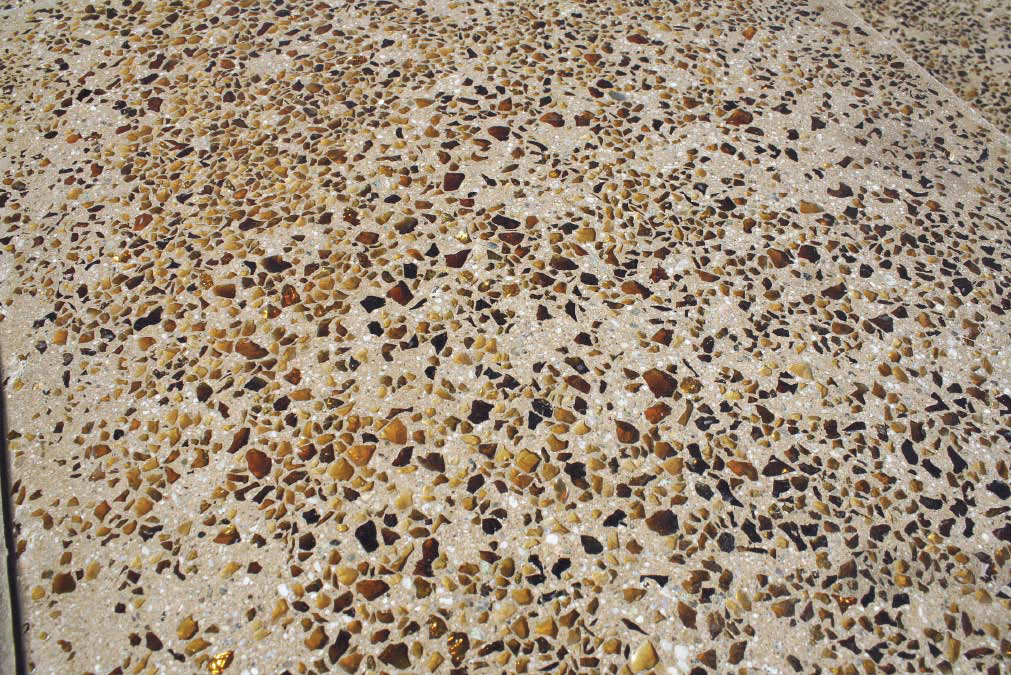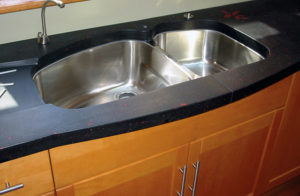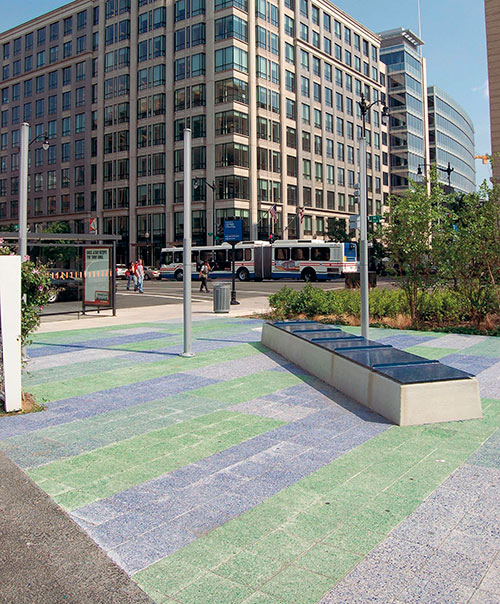
To successfully seed or mix these two materials, you often have to manage alkali-silica reaction. Here’s how.
Unlike water and oil, glass and concrete do mix and can marry well under the right circumstances. On the other hand, the union may not remain solvent if the chemistry isn’t there to deter the main reason this coupling would meet its demise: alkali-silica reaction (ASR).
It’s a well-documented fact that combining glass aggregate with portland cement may trigger ASR. What happens is the silica in the glass reacts with calcium hydroxide (a powerful alkali with a pH of 12) in the portland cement and forms a siliceous gel.
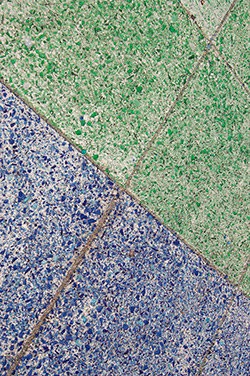 This gel within the cement paste absorbs water and swells. If the swelling is sufficient, the pressure can cause microcracking, expansion and ultimately the deterioration of the surrounding concrete. Sometimes, this happens early on. Other times it can take years for the problem to surface.
This gel within the cement paste absorbs water and swells. If the swelling is sufficient, the pressure can cause microcracking, expansion and ultimately the deterioration of the surrounding concrete. Sometimes, this happens early on. Other times it can take years for the problem to surface.
The amount of damage inflicted by ASR on concrete depends upon the volume, the piece or particle size, and even the color of the glass.
According to a report issued by the Clean Washington Center (CWC), increasing the surface-area-to-volume ratio of glass (in other words, using smaller shards) will reduce the effects of the reaction. Using smaller pieces of glass tends to speed up ASR, which gives the gel time to swell before the concrete hardens, limiting potential damage. Powdered glass will be consumed by the process to the degree that it causes no ASR at all.
As for color, testing shows that green glass experiences little or no ASR. Adam Silver, president of American Specialty Glass in North Salt Lake, Utah, believes this is due to the chemical makeup inherent in green glass. Clear glass showed a more significant reaction in tests conducted at the same time and under the same controls, Silver states.
A solution in the mix
When using recycled glass aggregate with concrete, “ASR can be a concern,” says Silver, “but if you use your head and take away a couple of things that cause the reaction, you don’t need to worry. Problems can be overcome with the right mix design.”
According to Mark Celebuski, general manager for Pinnacle Cast Concrete in Lancaster, Pa., using an extremely low-alkali cement, a lithium-based admixture, or a pozzolan that reacts with calcium hydroxide will keep ASR in check. The pozzolan transforms calcium hydroxide so there’s none left to react with the glass aggregate.
If you decide to go the low-alkali cement route, the American Society for Testing Materials defines this kind of cement as consisting of less than 0.6 percent by weight of alkalis.
According to a CWC report, the amount of alkali in your mix from portland cement can also be reduced by replacing up to 25 percent of the cement with a low-alkali siliceous pozzolan, such as ASTM Class F fly ash.
Celebuski says his favorite supplementary cementitious material for countertops is Bottle-Pozz, a product from Fishstone he’s been testing for about three years. It’s been on the market for about one.
A high-quality pozzolan made from post-consumer glass bottles, Bottle-Pozz is crushed glass sterilized in a rotary kiln that burns off contaminants such as sugar and paper. The clean pieces are then run through a finishing mill that produces an off-white glass powder with particles similar in size to those in portland cement.
So this pulverized glass replaces alkaline material, and on top of that, its particles are small enough to be fully transformed by the alkali that remains, forming calcium silicates. “It seems weird but as glass is ground finer and finer it no longer causes ASR,” says Celebuski. “If the particle is small enough, the calcium hydroxide consumes it and there’s none left to cause ASR.” The glass powder, which is recommended for projects where you would use white cement, also prevents efflorescence and makes the concrete stronger.
The CWC report also notes that a set retarder can be added to slow the cement’s curing time. The retarder allows more time for the ASR gel to form and expand before the concrete hardens. Using a retarder along with an air-entrainment enhancer will allow the gel to expand in evenly dispersed microscopic air pockets in the cement, reducing the potential for structural weakness.
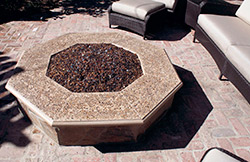 Should you wash the glass first?
Should you wash the glass first?
The glass aggregate used in decorative concrete comes from post-consumer glass, which largely consists of amber or green bottles, and post-industrial glass from things like windows and windshields. “The bottle glass is not as pristine a product,” Silver says, noting that his company doesn’t wash the bottles before they go through an incinerator to clean them. After the bottles are sterilized with heat, they are crushed into various-sized pieces and sold. Typically, the batches are 90 percent the same color due to the variation in hues of the recycled bottles.
The post-consumer glass could have traces of sugar and paper in the mix, Silver concedes. “Most of the time it’ll be fine, but there’s a small chance you would have an adhesion problem when it’s recycled because of the sugar,” which can cause an unpredictable increase in setting time and decrease in the concrete’s strength. “You could use an acrylic fortifier to help with adhesion if it’s an issue.”
Or, urges Jeffrey Girard, P.E., president of The Concrete Countertop Institute in Raleigh, N.C., you could wash the glass yourself. When you get a batch of recycled glass, put some in a bucket overnight and see what the water looks like in the morning. If it’s dirty, he suggests tumbling the pieces in a drum mixer with some water, a healthy dose of bleach, a good cleaner and a degreaser. When you’re done, rinse the glass until the water runs clean and let it dry.
“The glass needs to be clean for the best performance,” he says. “You can’t make good concrete with bad ingredients.”
If squeaky-clean glass is a priority, your best bet is post-industrial glass, although it is expensive, Silver says. The furnace heats up to as much as 2,500 degrees Fahrenheit and melts the glass, which is then colored and put into a usable form. Because of the more complicated process, “it’s double or triple the price of post-consumer,” he says.
For those contractors working with the LEED program, the government awards more points for using recycled post-consumer glass than for recycled post-industrial because of the processes used to prepare them for market.
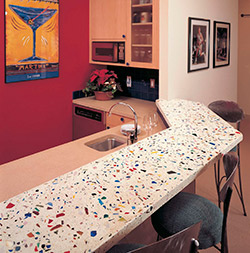
How water promotes ASR
Besides a reactive aggregate such as glass and an alkali-rich environment, water is necessary to fuel ASR. Girard warns contractors to be careful when using glass aggregate in areas prone to a lot of moisture.
“A lot depends on where the concrete is going to be placed. If it’s inside in a dry environment, ASR is not an issue,” he says. “The root of the problem relates to the wetting and drying cycles. If the concrete gets wet, the alkaline environment dissolves some of the glass and creates a gel that forms a hard coating when it dries. When that gel gets wet it swells and doesn’t shrink when it dries. It cracks the concrete and you get spalling and structural degradation.”
Contractors also need to minimize the amount of water in the initial mix, which will help decrease the gel’s expansion. A high-range water-reducing admixture can be added if the resulting mixture is difficult to pour.
